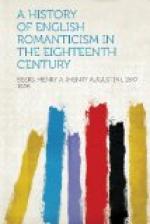CHAPTER VI.
The School of Warton
In the progress of our inquiries, hitherto, we have met with little that can be called romantic in the narrowest sense. Though the literary movement had already begun to take a retrospective turn, few distinctly mediaeval elements were yet in evidence. Neither the literature of the monk nor the literature of the knight had suffered resurrection. It was not until about 1760 that writers began to gravitate decidedly toward the Middle Ages. The first peculiarly mediaeval type that contrived to secure a foothold in eighteenth-century literature was the hermit, a figure which seems to have had a natural attraction, not only for romanticizing poets like Shenstone and Collins, but for the whole generation of verse writers from Parnell to Goldsmith, Percy and Beattie—each of whom composed a “Hermit”—and even for the authors of “Rasselas” and “Tom Jones,” in whose fictions he becomes a stock character, as a fountain of wisdom and of moral precepts.[1]
A literary movement which reverts to the past for its inspiration is necessarily also a learned movement. Antiquarian scholarship must lead the way. The picture of an extinct society has to be pieced together from the fragments at hand, and this involves special research. So long as this special knowledge remains the exclusive possession of professional antiquaries like Gough, Hearne, Bentham, Perry, Grose,[2] it bears no fruit in creative literature. It produces only local histories, surveys of cathedrals and of sepulchral monuments, books about Druidic remains, Roman walls and coins, etc., etc. It was only when men of imagination and of elegant tastes were enlisted in such pursuits that the dry stick of antiquarianism put forth blossoms. The poets, of course, had to make studies of their own, to decipher manuscripts, learn Old English, visit ruins, collect ballads and ancient armor, familiarize themselves with terms of heraldry, architecture, chivalry, ecclesiology and feudal law, and in other such ways inform and stimulate their imaginations. It was many years before the joint labors of scholars and poets had reconstructed an image of medieval society, sharp enough in outline and brilliant enough in color to impress itself upon the general public. Scott, indeed, was the first to popularize romance; mainly, no doubt, because of the greater power and fervor of his imagination; but also, in part, because an ampler store of materials had been already accumulated when he began work. He had fed on Percy’s “Reliques” in boyhood; through Coleridge, his verse derives from Chatterton; and the line of Gothic romances which starts with “The Castle of Otranto” is remotely responsible for “Ivanhoe” and “The Talisman.” But Scott too was, like Percy and Walpole, a virtuoso and collector; and the vast apparatus of notes and introductory matter in his metrical tales, and in the Waverley novels, shows how necessary it was for the romantic poet to be his own antiquary.




